New 1981-2010 Averages being used this year.
Note: This publication is currently undergoing major revisions. The current publication will be replaced with a new publication based on stakeholder requirements and scientific advances. We expect to begin sharing details on this soon. If you have input on content, format, or publication frequency at any time, please contact us at cbrfc.webmasters@noaa.gov.Upper Colorado Water Supply Outlook, April 1, 2012Upper Colorado Water Supply Outlook, April 1, 2012
Contents
Upper Colorado Summary
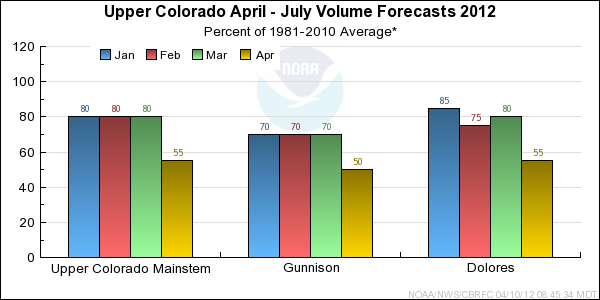
*Median of forecasts within each basin.
Upper Colorado Mainstem Basin Conditions
The following conditions influenced this month's forecasts:
Precipitation:
Seasonal October through March
precipitation
was near 70 percent of average in the Upper Colorado mainstem basin.
March
precipitation was much below average at
just 30 percent of average. This is the driest March on record at
many of the SNOTEL sites in the basin.
Snow:
April 1st snow water equivalent was near 50 percent of average in the basin as a whole.
In a normal year snow continues to accumulate through March, and into the middle of April
at higher elevations. However this year melt occurred during March,
especially toward the end of the month and even at SNOTEL sites above 11,000 feet.
The April 1 snow water equivalent values are the lowest on record at many of the
SNOTEL sites in the basin.
--- Upper Colorado basin
snow
water equivalent plot
Streamflow:
March streamflow was near 120 percent of average in the basin as a whole.
It ranged from 110 percent to 220 percent of average at individual sites.
The March volume at about one third of the forecast points in the Upper
Colorado basin ranked in the top three of their historical records.
Soil Moisture:
Modeled
soil
moisture states were above average heading into the winter.
Climate Forecasts:
La Nina climate conditions exist but these do not show a strong correlation with winter
precipitation in the Upper Colorado mainstem basin, and therefore were not influential in the development
of streamflow volume forecasts.
Forecast Summary:
A wet October was followed by much below average precipitation in November and Decemeber. Near average
precipitation occurred in January and February. As of March 1st the Upper Colorado had its best
conditions of the season with both the seasonal precipitation and basin snow water equivalent near 80 percent of average.
However, March 2012 was one of the warmest and driest March's in the last 30 years in the Upper Colorado basin
and as of April 1st the snow water equivalent was just 50 percent of average with seasonal precipitation
near 70 percent of average. Because of the unusual conditions during March there were
very large drops in the April through July forecast runoff volumes from what was issued March 1st.
Current April through July streamflow volume
forecasts
range between 46 and 68 percent of average with a median value of 55 percent.
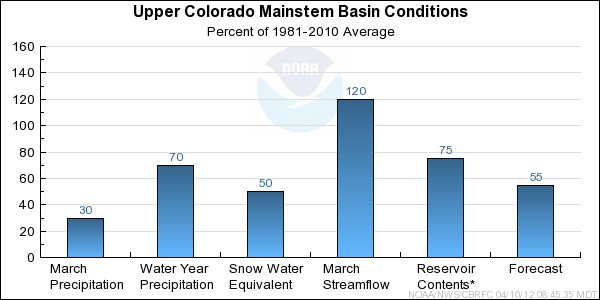
* Percent usable capacity, not percent average contents.
Click for multi-month Graph.
Gunnison Basin Conditions
The following conditions influenced this month's forecasts:
Precipitation:
Seasonal October through March
precipitation ranged from 70 to 95 percent of
average in the Gunnison Basin.
March
precipitation was much below average over the entire Gunnison Basin. For
individiual sites March precipitation ranged from 15 to 55 percent of average, with a Basin
average of 35 percent.
Snow:
April 1st snow water equivalent was 60 percent of average in the Gunnison Basin, but varied with several
locations below 50 percent of average and some below 40 percent of average. An early onset of the snow melt
occurred at all elevation levels due to much above average temperatures in March.
Gunnison Basin
snow
water equivalent plot
Streamflow:
March streamflow volumes were above average due to the early snow melt. Runoff volumes in March ranged from
near average to near 145 percent of average.
Soil Moisture:
Modeled
soil
moisture states were above average entering the winter season.
Climate Forecasts:
La Nina climate conditions existed throughout the winter but these do not show a strong
correlation with winter precipitation or Apri-July runoff volumes in the Gunnison Basin.
Therefore they were not influential in the development of streamflow volume forecasts.
Forecast Summary:
A wet October was followed by drier condtions in November and December and very dry conditions in March.
Precipitation was near or above average at most locations in January and February. Seasonal precipitation
was near 75 percent of average as of March 1st. Snow melt occurred at all elevations due to dry and
warm conditions in March. By April 1st the Gunnison Basin snow water equivalent was reduced to 60 percent
of average with several sites reporting less than 50 percent of average. Streamflow forecasts were
reduced significantly from those issued March 1st. April-July
streamflow runoff volumes are expected to range between 45 and 70 percent of the 1981-2010 average.
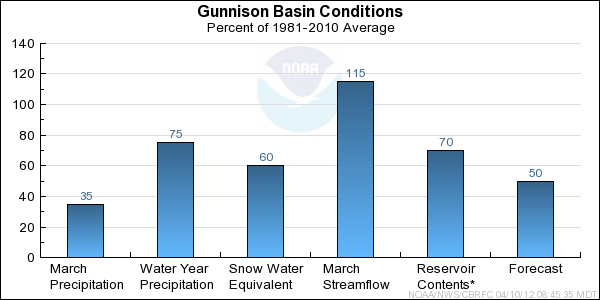
* Percent usable capacity, not percent average contents.
Click for multi-month Graph.
Dolores Basin Conditions
The following conditions influenced this month's forecasts:
Precipitation:
Seasonal October through March
precipitation ranged between 75 and
100 percent of average in the Dolores Basin.
March
precipitation was much below average. For individual sites
March precipitation ranged from 25 to 50 percent of average, with a Basin average of 35 percent.
Snow:
April 1st snow water equivalent was near 50 percent of average in the Dolores Basin, with a few
locations near or below 40 percent of average. An early onset of the snow melt
occurred at all elevation levels due to much above average temperatures in March.
Dolores Basin
snow
water equivalent plot
Streamflow:
March streamflow volumes in the Dolores River Basin were near 105 percent of average.
Soil Moisture:
Modeled
soil
moisture states were near average entering the winter season.
Climate Forecasts:
La Nina climate conditions existed throughout the winter but these do not show a strong correlation
with winter precipitation or April-July runoff volumes in the Dolores Basin. Therefore,
it was not influential in the development of streamflow volume forecasts.
Forecast Summary:
Near average soil moisture existed in the Dolores River Basin entering the winter
season. Seasonal precipitation was below average for most areas as of April 1st.
Snow melt occurred at all elevations due to dry and warm conditions in March. By April 1st
the Dolores Basin snow water equivalent was reduced to 50 percent of average with several
sites reporting near 40 percent of average. Streamflow forecasts were reduced significantly
from those issued March 1st. April-July
streamflow
runoff volumes are expected to range from 45 to 65 percent of the 1981-2010 average.
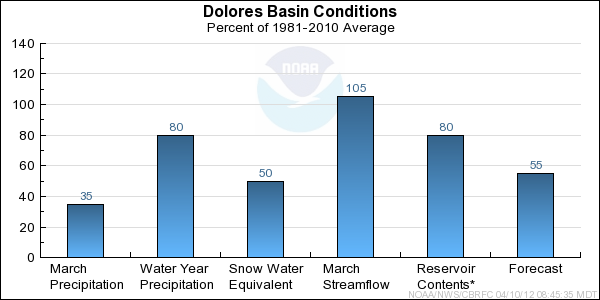
* Percent usable capacity, not percent average contents.
Click for multi-month Graph.
Differences between the full period forecasts and the residual forecasts may not exactly equal the actual observed volumes due to rounding conventions (see Definitions section).
Reservoir Monthly Inflow Forecasts
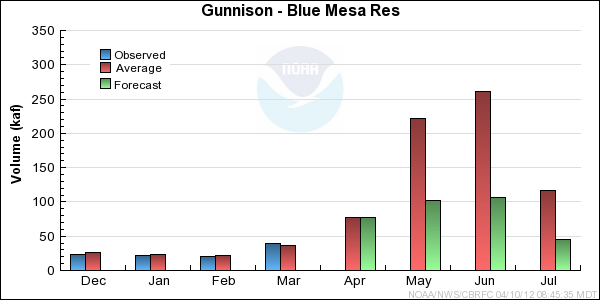
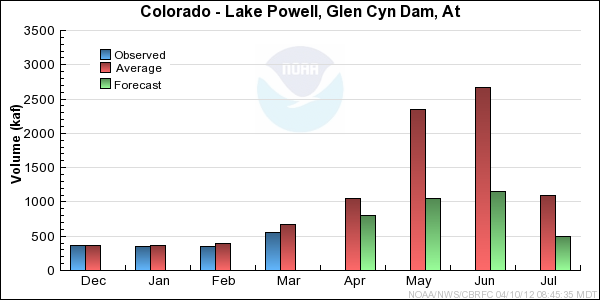
Monthly Streamflows
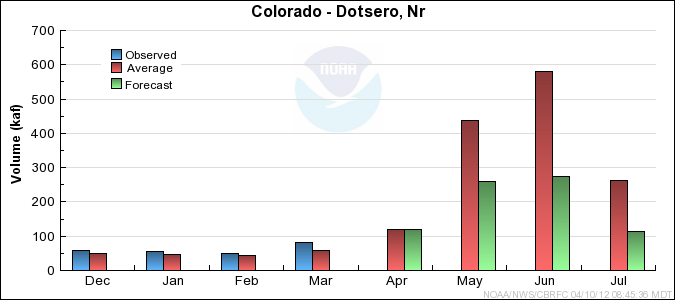
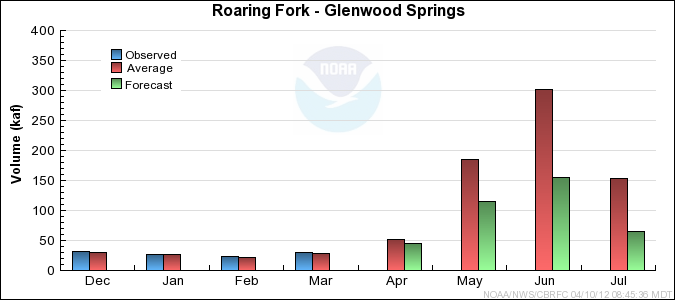
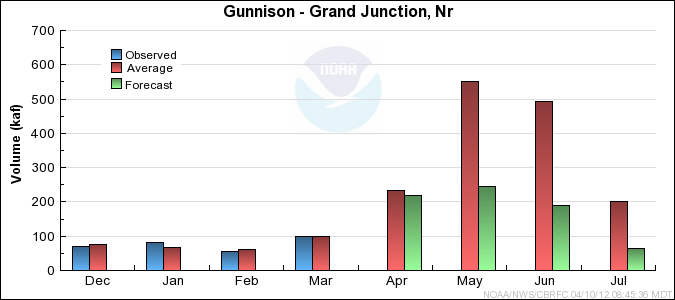
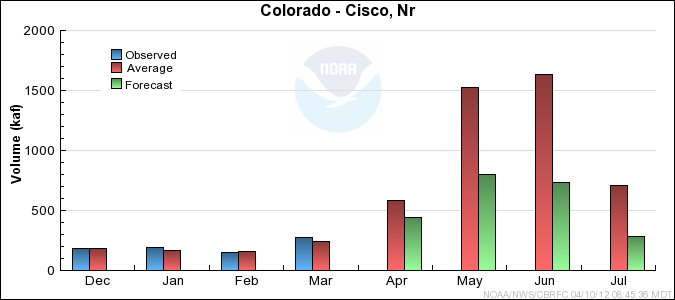
Precipitation Maps
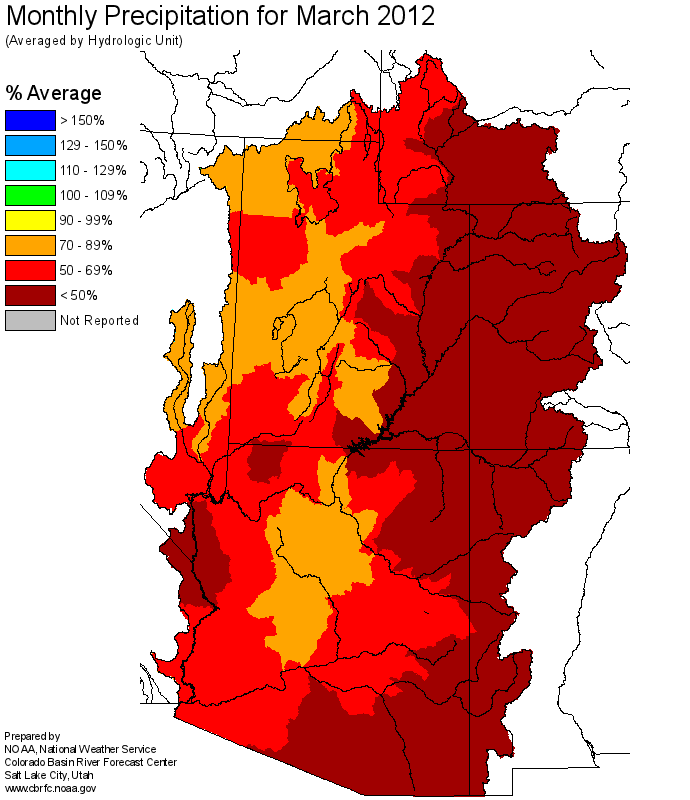
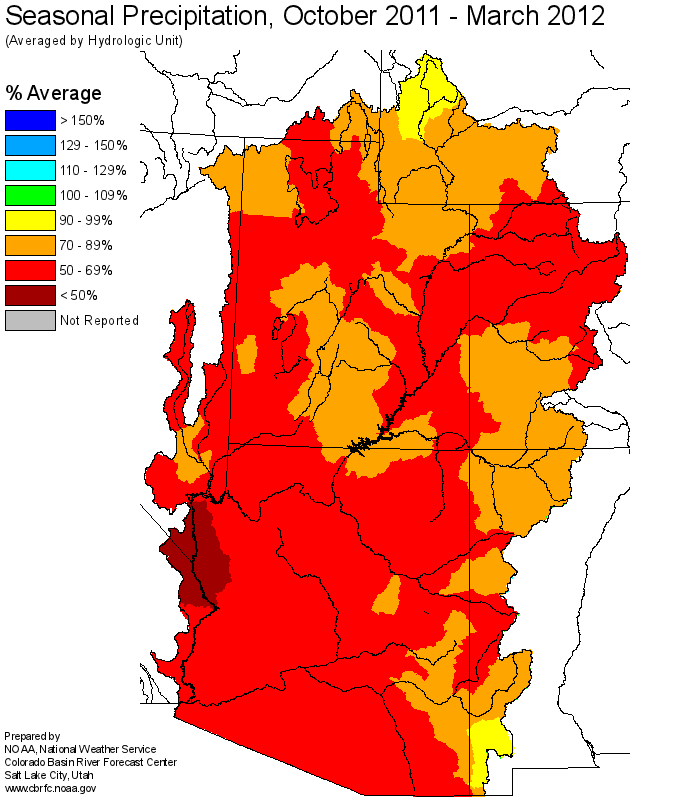
Hydrologist: Brenda Alcorn, Greg Smith













